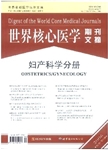卵巢上皮癌二探手术阳性患者预后因子的研究
Identification of prognostic factors after positive second-look surgery in epithelial ovarian carcinoma作者机构:Gynecology Service Department of Surgery Memorial Sloan-Kettering Cancer Center 1275 York Avenue MRI-1026 New York NY 10021 United States
出 版 物:《世界核心医学期刊文摘(妇产科学分册)》 (Core Journal in Obstetrics/Gynecology)
年 卷 期:2006年第2卷第10期
页 面:41-42页
学科分类:1002[医学-临床医学] 100214[医学-肿瘤学] 10[医学]
主 题:二探手术 卵巢上皮癌 预后因子 残留病灶 生存时间 初始治疗 末次随访 化疗药物 个体化化疗 持续性
摘 要:Objective.: The objective of this study was to identify independent prognostic factors for survival in patients with epithelial ovarian cancer who had persistent disease identified at second look surgery. Methods.: We performed a retrospective chart review of all patients with epithelial ovarian cancer who had positive findings at second-look surgery between June 1991 and June 2002. All patients achieved a complete clinical remission after a prescribed course of primary therapy. Survival was determined from the time of second-look surgery until last follow-up or death. Results.: The study included a total of 262 patients, with a median age of 54 years(range, 22-80). Of the 262 patients, 166(63%) had died of disease. Records of initial(salvage) treatment after the positive second-look surgery were available for 243 patients. Therapies included the following: intraperitoneal(IP) cisplatin, 71(29%); IP cisplatin combined with a second drug, 53(22%); IP therapy other than cisplatin, 29(12%); intravenous(IV) chemotherapy, 50(21%); IP and IV therapy, 35(14%); and oral chemotherapy, 5(2%). Of the 13 potential prognostic factors analyzed, only 2 factors emerged that, when combined, were significant-residual disease after primary surgery and size of persistent disease found at second-look surgery. Patients with ≤1 cm residual disease after primary surgery and microscopic disease at second-look surgery had significantly improved survival. Conclusion.: In our analysis, the only prognostic factor for survival in patients with positive second-look procedures was a combination of residual disease after primary surgery and size of persistent disease identified at second-look surgery. No individual chemotherapy treatment imparted a survival advantage. Novel that therapeutic approaches are needed in this setting.



